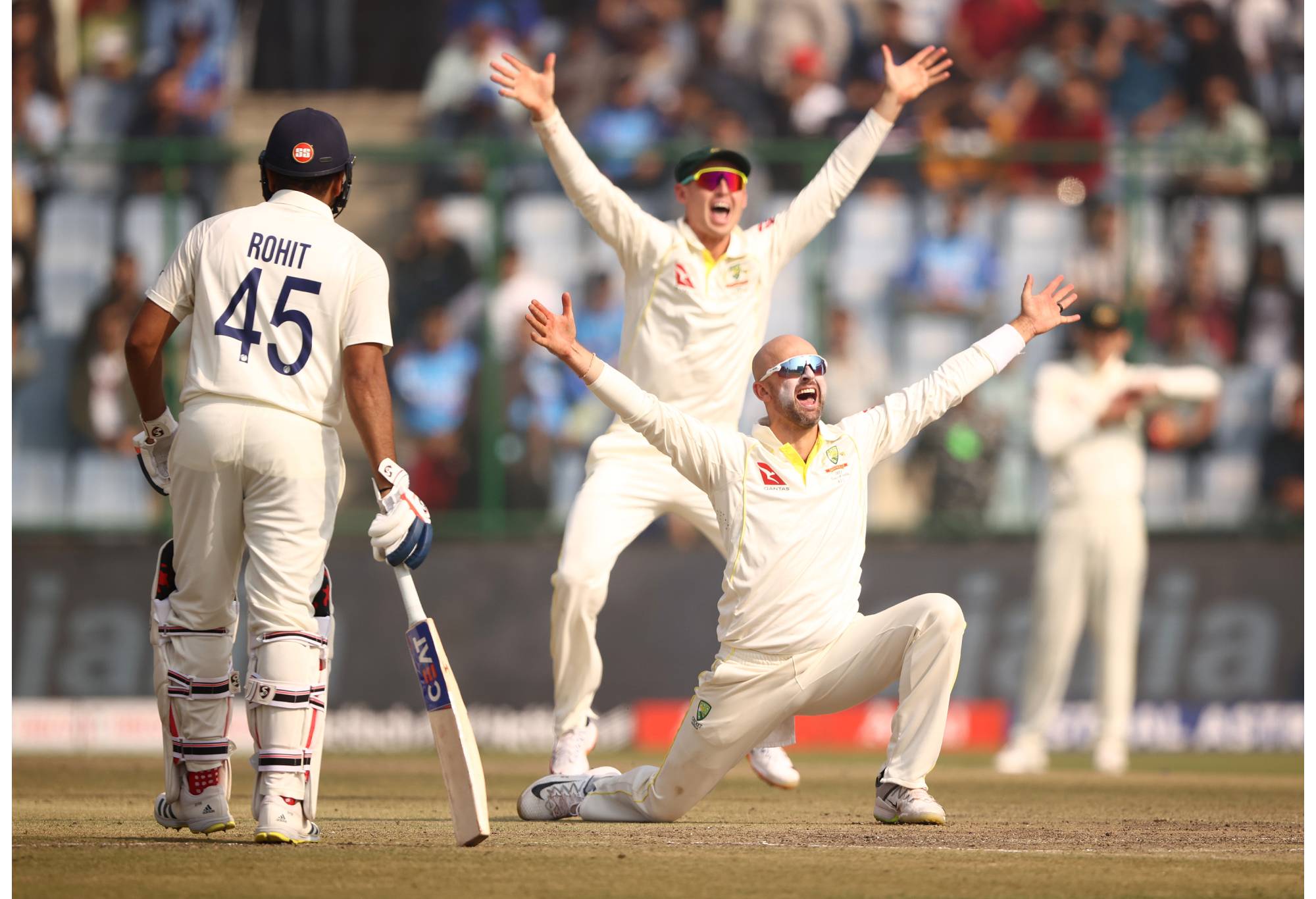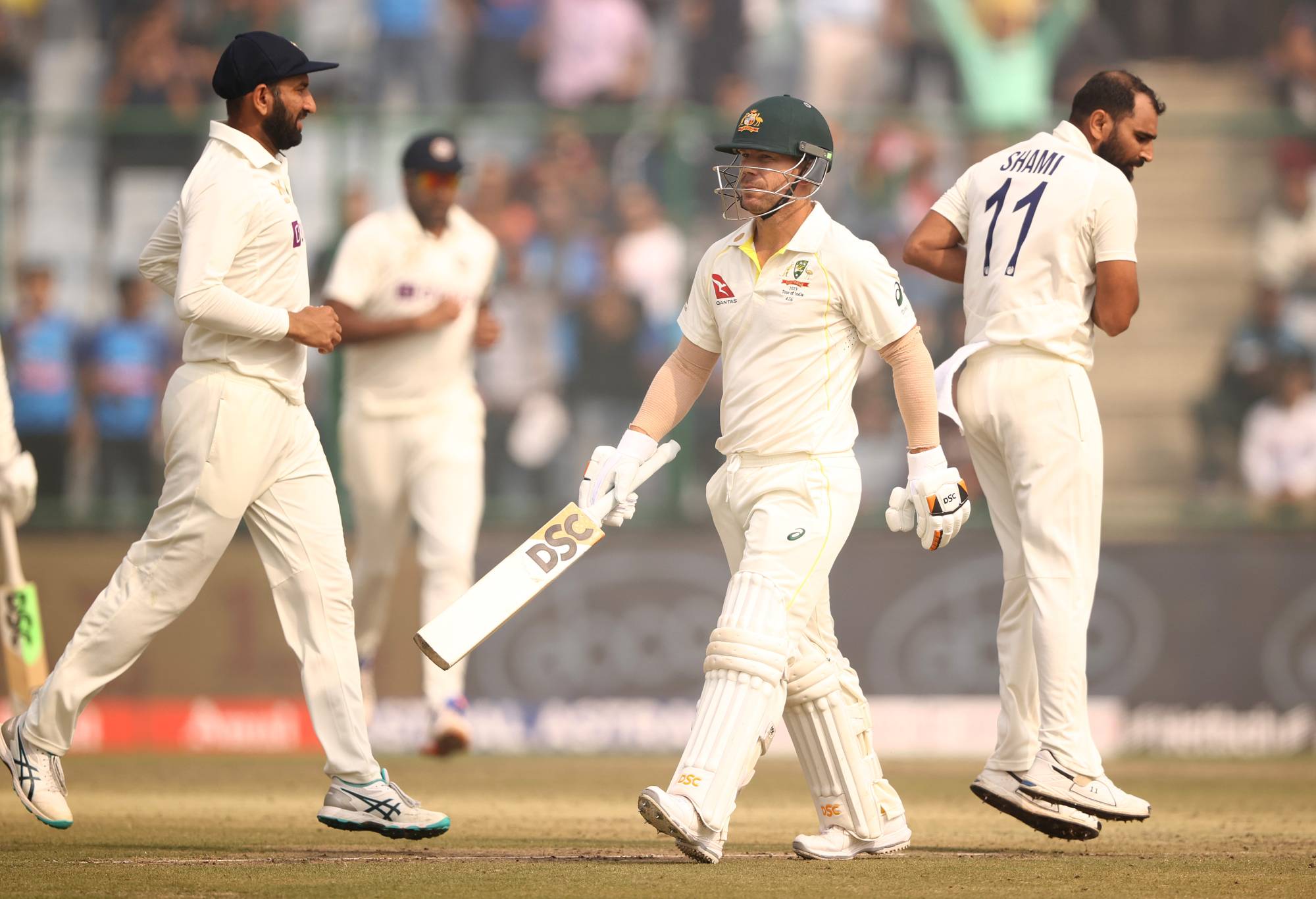Australia have again shown how exactly not to use Test cricket’s Decision Review System with three costly blunders on day two of the second Test.
The Aussies have no one to blame but themselves but the whole review system needs to be overhauled.
Video review was brought in to prevent howlers but the current set-up allows teams the opportunity to double-check marginal calls.
The ICC increased the number of unsuccessful reviews per innings from two to three in 2021 as part of a trade-off for going back to having one local umpire standing in each Test rather than two neutrals, which also helped lessen costs and travel during the pandemic.
CLICK HERE for a seven-day free trial to watch cricket on KAYO
And now teams also don’t burn a review if they’re denied by an umpire’s call.

Nathan Lyon appeals unsuccessfully for the wicket of Cheteshwar Pujara. (Photo by Robert Cianflone/Getty Images)
This all adds up to captains having too many chances to go upstairs if they think the umpire has misjudged the ball pitching outside leg for an LBW call.
That’s not what DRS was brought in to do – its purpose was to stop a blatantly poor decision, as in David Warner reviewing an LBW dismissal when he knew he inside-edged it onto his pad or Rohit Sharma petulantly whacking his bat to make the signal when he was given out for a bat-pad catch when he missed the ball.
Two incorrect reviews per innings (with umpires call verdicts not counting) should be more than enough. It would stop instances like Australia’s three blunders on day two when they questioned not out verdicts unsuccessfully.
It must have been karma in the land where it originated when the Aussies chose not to review a Nathan Lyon LBW shout from the second ball that Cheteshwar Pujara faced and replays showed he would have been sent on his way. Luckily for them, it didn’t matter much because Pujara was on his way for duck soon after in his 100th Test.
With Lyon bagging four wickets, including Shreyas Iyer via a superb reflex catch from Peter Handscomb, the tourists still managed to dominate the first session despite their review dramas to have India 4-88, trailing by 175.
And despite the tail wagging and India getting within one run of their first innings total, the Aussies enter day three in a dominant position after Travis Head’s unbeaten 39 off 40 gave them a 62-run advantage by stumps.
Former Australian captain Allan Border on Fox Cricket said one of the three unsuccessful reviews – a catch from Virat Kohli that he didn’t go close to hitting was “as bad as it gets”.
“When you have those powwows, you’ve just got to take the emotion as much as you can out of it. The keeper is really vital, he’s got to have a really strong view on it otherwise you’re going to get a lot of them wrong.”
Mike Hussey added that the Australians paid the price for being too eager with their reviews.
“I think this is an indication of the mentality of the Australians coming into today. They were so desperate to get early wickets and I think they probably just lost a bit of control there,” he said.
Captains would be much more judicious with their reviews if they know there’s only two they can burn.
An MCC study found that DRS reviews soak up four precious minutes on average, slowing Test cricket down even further at a time when the authorities are trying to speed the game up.
The MCC’s World Cricket Committee also recommended that when a not out call is sent for review, the fielding team should remain in their positions, the batters should stay in proximity of the pitch and no drinks should be brought onto the field by squad members because “it took an average of 25 seconds for the fielding side to be ready to bowl the next ball” after a not out decision had been confirmed.
For several years India were reluctant to agree to DRS in Test series yet it’s set up ideally for them when they’re playing at home – there is no was an LBW decision will go over the stumps on the low wickets and with spinners who specialise in targeting the wickets, they should have been early adopters of the technology.
Warner’s pain could be Renshaw’s gain
With David Warner ruled out for the remainder of the second Test against India, Travis Head has seized the opportunity to retain his place in the team with his quickfire 39 late on day two.
Head only faced 40 deliveries but bludgeoned five fours and a six to not only restore Australia’s momentum heading into day three but to also make a case for him to remain at the top of the order for the remaining two Tests.
With Cameron Green set to return from his finger injury at Indore for the third Test on March 1, it means Head or Peter Handscomb will be squeezed out of the middle order.
Head’s elevation to opener for the second innings shows that Australia’s brains trust views him as more than a makeshift opener and he could very well replace David Warner as Usman Khawaja’s partner for the rest of the Border-Gavaskar Trophy series.
Mid-game call-up Matt Renshaw will slot in at five or six in the middle order in the second innings so he appears unlikely to replace Warner as opener.
Renshaw looked out of his depth in the middle order last week during the first Border-Gavaskar Trophy Test at Nagpur with a golden duck and two, but with Warner ruled out after he failed his concussion test after day one, the Queenslander will get a chance to make amends.
The 36-year-old was struck in the head, and also copped a nasty blow to his forearm, as he scratched his way to 15 on day one and after not fielding in the final session, was subsequently withdrawn from the match as he was displaying symptoms and failed a concussion test.

David Warner walks off after he was dismissed by Mohammed Shami. (Photo by Robert Cianflone/Getty Images)
Whether he adds to his tally of 8143 runs and 102 Tests remains to be seen – based on recent form alone, particularly his twin failures of 1 and 10 in Nagpur, he deserves to be dropped but Australia’s notoriously gun-shy selectors could still give him one more chance if Renshaw falls cheaply.
If Head goes on to make a big score on day three, we may have seen the last of Warner at Test level.
His regular opening partner Usman Khawaja said it was premature to bring down the curtain on Warner’s career when he fronted the post-match media conference on day one.
“Three innings is not enough for me – I think there’s still a long way to go in this Test series,” Khawaja said. “Dave has been such a terrific player for such a long time. Every time his back is against the wall he produces something so we’ll see.”
Delhi should lose Test status over smog
How bad does Delhi’s air quality have to get before it’s considered an impediment to India’s capital city hosting international cricket.
Delhi was ranked in the top five cities worldwide for air quality on Saturday with a rating of 229 on the Air Quality Index, which is considered “very unhealhy”.
Sri Lankan players were vomiting on the field and wore face masks (long before it became somewhat more commonplace) during a Test at Delhi in 2017 and umpires were forced to stop play due to the haze of pollution which engulfed the playing arena.
The Sri Lankans brought in oxygen cylinders for their players in the change room to help them cope with the effects of playing elite sport in the smog.
Two matches in the Ranji Trophy had been abandoned the previous year due to the poor air quality.
There are restrictions on when people can drive their cars in Delhi (based on whether they have an odd or even number at the end of their licence plate) but pollution is still clearly a major issue.
If it was a requirement for Delhi to improve its air quality in order to continue to host international cricket, every local politician will be pledging significant changes to reduce the pollution as it’s a surefire vote-getting issue.






























































































